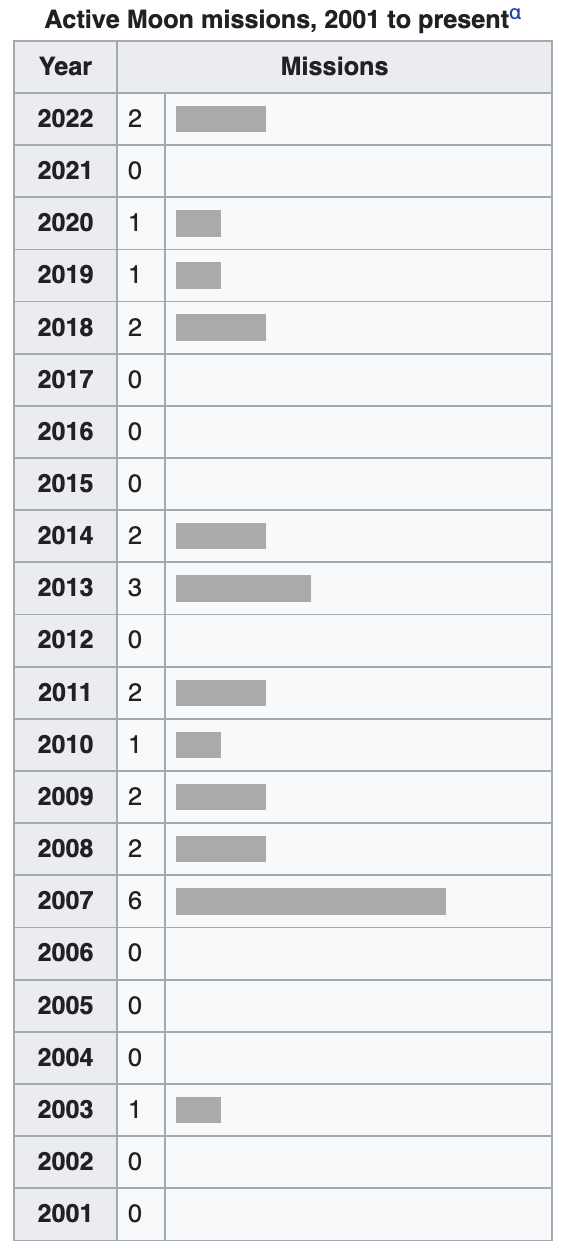As the US heads back to the Moon, the world differs greatly from what it was in the late 60s and early 70s. People in the US are far more cynical and skeptical than ever before. According to Gallup International, 8% of respondents agree that “The planet Earth is flat and what is everywhere written that it has a form close to a sphere is untrue”. A further 9% disagree that people have stepped on the Moon.
Two Decades of Moon Visitors
And while the Americans are wont to position this as "humanity's return to the Moon", the odder truth is that plenty of other countries have continued to head to the Moon since 2000.
Source: Wikipedia

The SLS's launch at the end of 2022 and the naming of the four astronauts who will orbit the moon on the next launch in April 2023, has concentrated attention on the Moon in the US and Canada. The recurring rhetoric is that it returns "us" to the moon. From a #CanadianSpace perspective, who is "us"? Do we align only with the US when there have been 25 missions to the moon in the last 22 years?
Apart from the SLS test launch last year, organizations put two space craft into lunar space. In 2022 (August) Danuri, a Korean Pathfinder Lunar Orbiter was launched on a Falcon 9 and (June) the CAPSTONE project was sent up on an Electron rocket.
Between 2007 and 2018, the Chinese successfully sent many missions to the moon, growing in complexity and difficulty. The Chinese Yutu-2 rover, launched in 2018 and landed in 2019, was the first to land on the far side of the moon. In 2020, the Chinese sent a lander which returned 1.7 kg of lunar samples.
The Indians are fielding increasingly sophisticated space missions, too. Chandrayaan-1, in 2008, was a successful lunar impacter mission. The Indian Space Research Organization (ISRO) in 2019 sent a lander and orbiter pair, Chandrayaan-2. Though the lander malfunctioned, the orbiter is still operational.
In 2014, Luxembourg's Manfred Memorial Moon Mission did a moon flyby and later deliberately impacted the moon in March 2022. Japan's JAXA sent two satellites in 2007 and the ESA an impacter in 2003. It's the Japanese iSpace mission which is building towards landing on the Moon with the Canadian Mission Control AI navigation software at the helm in May 2023.
ispace Inc. is a Japanese company born from the Google X-Prize competition which dared participants to land a rover on the moon, travel 500 m and send back high definition video and images. With 9 lunar missions planned (M1-M9), M1 represents the start of an impressive set of collaborations. Launched at the end of December M1 entered lunar orbit at the beginning of April and will make its landing attempt at the end of April.
Towards Commercial Space
While nobody claimed the Google X-Prize, a surprising number of companies were born from the efforts to claim the prize. Development timelines for the contest were highly optimistic, but those who continued after it ended are now seeing the fruits of their labours.
The government agencies pushing toward a return to the moon have never been bigger or better funded. Nor have there ever been so many of them, as countries around the world who have never had a space program before are setting up space agencies. What is unique, however, is how much they're relying on commercial enterprises instead of building their own equipment and training their own personnel. Instead of the United Arab Emirates (UAE) reaching out to NASA, ESA, or Roskosmos to take their first rover to the moon, they contacted ispace.
NASA's program Commercial Lunar Payload Services (CLPS) has been actively putting together missions heading toward the moon. The table below lists the landing sites and company landers NASA has already selected. 1
| Company (lander, if chosen) | Landing site | Landing date |
|---|---|---|
| ispace (M1) | Atlas crater | Late April 2023 |
| Astrobotic (Peregrine) | Sinus Viscositatis | Delayed from May 2023 |
| Intuitive Machines (Nova-C) | Malapert A | June 2023 |
| Intuitive Machines (Nova-C) | Shackleton Connecting Ridge | Late 2023 |
| Firefly Aerospace (Blue Ghost) | Mare Crisium | 2024 |
| Intuitive Machines (Nova-C) | Reiner Gamma | 2024 |
| ispace (M2) | Not yet announced | 2024 |
| Astrobotic (Griffin) | Nobile crater | November 2024 |
| Draper | Schrödinger Basin | 2025 |
| SpaceIL (Beresheet 2) | Not yet decided | 2025 |
| Not yet decided | Gruithuisen Domes | 2026 |
| Firefly Aerospace | Lunar far side | 2026 |
| Not yet decided | South pole region | 2026 |
Canadian Approaches
Governmental support for the Canadian space program is quite small compared to other efforts. Using back-of-the-napkin numbers, NASA's budget is \(22.5B USD, while Canada's is\)400M CAD (~$300M USD). This amounts to 1.3% of NASA's budget.
One outcome of this funding disparity is that the CSA could never fund a company as large as SpaceX.
SpaceX received an initial \(100M, which would exceed more than ⅓ of CSA's budget. It would be administratively irresponsible to make such a large bet on any single company; current bet sizes are between\)25-250,000. Since its inception SpaceX has received $10B in additional funding. If the CSA spent its entire budget, it would take over 33 years to equal such funding.
Instead, the CSA uses its connections and Canadian's technical prowess to foster unique opportunities for collaboration with NASA, the ESA and others, so Canadian companies and researchers can play at the highest levels. Fostering private companies provides the CSA with strategic opportunities that its funding alone could not buy.
Such strategic collaboration is why Canada is the only country outside of the EU with a permanent seat at the European Space Agency. It is why Canadian scientists will receive samples from the asteroid Bennu via the OSIRISREx mission. It is also why of the 4 seats going to the Moon on Artemis II, Canada could secure 1 for our astronauts.
Opportunities like these are rare and precious and NOT accidental. They point to the inevitable conclusion that money is only 1 factor in creating a successful national space program. 2
-
Witze. (2023, April 18). Private companies are flocking to the Moon — what does that mean for science? Nature. https://www.nature.com/articles/d41586-023-01045-6 ↩
-
Photo by malith d karunarathne on Unsplash ↩
